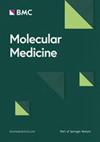N-formylmethionine-leucyl-phenylalanine protects against irradiation-induced damage to hematopoiesis and intestines
IF 6
2区 医学
Q1 BIOCHEMISTRY & MOLECULAR BIOLOGY
引用次数: 0
Abstract
Ionizing radiation (IR), including radiotherapy, can exert lasting harm on living organisms. While liposaccharide (LPS) offers resistance to radiation damage, it also induces toxic responses. Thankfully, an LPS analogue called N-formylmethionine-leucyl-phenylalanine (fMLP) holds the potential to mitigate this toxicity, offering hope for radiation protection. Survival of C57BL/6 mice exposed to IR after administration with fMLP/LPS/WR-2721 or saline was recorded. Cell viability and apoptosis assay of bone marrow (BMC), spleen and small intestinal epithelial (HIECs) cells were tested by Cell Counting Kit-8 (CCK-8) and flow cytometry assay. Tissue damage was evaluated by Hematoxilin and Eosin (H&E), Ki-67, and TUNEL staining. RNA sequencing was performed to reveal potential mechanisms of fMLP-mediated radiation protection. Flow cytometry and western blot were performed to verify the radiation protection mechanism of fMLP on the cell cycle. The survival rates of C57BL/6 mice exposed to ionizing radiation after administering fMLP increased. fMLP demonstrated low toxicity in vitro and in vivo, maintaining cell viability and mitigating radiation-induced apoptosis. Moreover, it protected against tissue damage in the hematopoietic and intestinal system. RNA sequencing shed light on fMLP’s potential mechanism, suggesting its role in modulating innate immunity and cell cycling. This was evidenced by its ability to reverse radiation-induced G2/M phase arrests in HIECs. fMLP serves as a promising radioprotective agent, preserving cells and radiosensitive tissues from IR. Through its influence on the cell cycle, particularly reversing radiation-induced arrest in G2/M phases, fMLP offers protection against IR’s detrimental effects.N-甲酰基蛋氨酸-亮氨酰-苯丙氨酸可防止辐照引起的造血和肠道损伤
包括放射治疗在内的电离辐射(IR)可对生物体造成持久伤害。虽然脂糖(LPS)能抵抗辐射损伤,但它也会诱发毒性反应。值得庆幸的是,一种名为 N-甲酰基蛋氨酸-亮氨酰-苯丙氨酸(fMLP)的 LPS 类似物具有减轻这种毒性的潜力,为辐射防护带来了希望。在使用 fMLP/LPS/WR-2721 或生理盐水后,记录了暴露于 IR 的 C57BL/6 小鼠的存活率。通过细胞计数试剂盒-8(CCK-8)和流式细胞仪检测骨髓(BMC)、脾脏和小肠上皮细胞(HIECs)的细胞活力和凋亡。组织损伤通过血色素和伊红(H&E)、Ki-67和TUNEL染色进行评估。进行了 RNA 测序,以揭示 fMLP 介导辐射防护的潜在机制。流式细胞术和Western印迹验证了fMLP对细胞周期的辐射防护机制。给C57BL/6小鼠注射fMLP后,它们在电离辐射中的存活率提高了。fMLP在体外和体内均表现出低毒性,能维持细胞活力并减轻辐射诱导的细胞凋亡。此外,它还能保护造血系统和肠道系统免受组织损伤。RNA 测序揭示了 fMLP 的潜在机制,表明它在调节先天免疫和细胞周期方面发挥作用。fMLP是一种很有前途的辐射防护剂,能保护细胞和对辐射敏感的组织免受红外辐射的伤害。通过对细胞周期的影响,特别是逆转辐射诱导的 G2/M 期停滞,fMLP 可保护细胞免受红外线的有害影响。
本文章由计算机程序翻译,如有差异,请以英文原文为准。
求助全文
约1分钟内获得全文
求助全文
来源期刊

Molecular Medicine
医学-生化与分子生物学
CiteScore
8.60
自引率
0.00%
发文量
137
审稿时长
1 months
期刊介绍:
Molecular Medicine is an open access journal that focuses on publishing recent findings related to disease pathogenesis at the molecular or physiological level. These insights can potentially contribute to the development of specific tools for disease diagnosis, treatment, or prevention. The journal considers manuscripts that present material pertinent to the genetic, molecular, or cellular underpinnings of critical physiological or disease processes. Submissions to Molecular Medicine are expected to elucidate the broader implications of the research findings for human disease and medicine in a manner that is accessible to a wide audience.
 求助内容:
求助内容: 应助结果提醒方式:
应助结果提醒方式:


